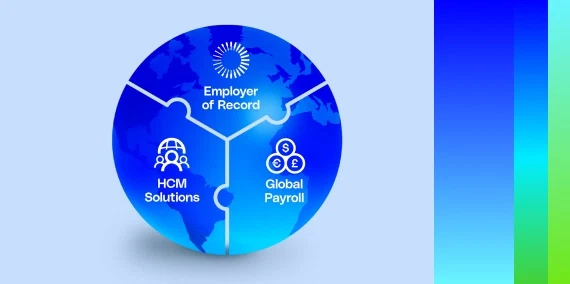Engaged employees are at the core of a positive organizational culture. The way your company treats employees — and how employees treat one another — can either positively affect workplace culture or place your organization at risk of losing valuable talent.
Yet, according to Gallup, only 23% of global employees are considered “engaged.” What can companies do to improve employee engagement? Let’s explore what makes a strong employee engagement strategy, and how to improve the employee experience from day one with a best-in-class Employer of Record (EOR) solution.
What is employee engagement?
Global employee engagement is a measure of how committed employees are to a company, including their alignment with company principles, culture, and goals. With that in mind, what is a highly engaged employee? A highly engaged employee is involved and enthusiastic about their job and work environment.
What are the negative effects of poor employee engagement? After trending upwards for years, engagement has recently hit its lowest point in a decade with 50% of the global workforce “quiet quitting.” From lost revenue to low morale, poor employee satisfaction can have negative impacts on any work culture and cause:
1. Increased stress.
When measuring employee engagement in 2023, Deloitte reported roughly half of Gen Zs (52%) and millennials (49%) feel burned out at work. Disengaged team members are typically more stressed than their engaged co-workers. Stress contributes to a higher employee turnover rate, which can be costly for your company.
2. High turnover.
Many employees will leave a company if there’s a lack of promotional opportunities or the lure of a more attractive job offer. Administrative tasks like recruitment, onboarding, and training of new hires will cost your company more if your talent moves to another company.
3. Slower growth.
If employees feel they don’t receive fair pay, lack a connection with co-workers, or don’t find purpose in their work, they may feel less invested in your company’s growth goals.
4. Lost revenue.
If workers are unhappy, their motivation will suffer, which can decrease productivity. Ultimately, this can equate to lost revenue for your company. In fact, disengaged or unhappy employees cost the world USD 8.8 trillion, or 9% of global GDP.
5. More absenteeism.
Research shows employees that feel more detached from their organizations are less likely to connect with the company mission and purpose. Poor employee engagement often leads to absenteeism due to low motivation. Engaged employees make it a point to show up to work — highly engaged business units realize an 81% difference in absenteeism and a 14% difference in productivity.
What are the benefits of employee engagement?
Highly engaged employees tend to feel satisfied with their contribution and impact. In fact, new research from MIT found that health and happiness at work are driving forces in the decision to stay at or leave a job.
But remember: Being happy at work isn’t just great for employees. Strong engagement is also a win for employers. Recent research from Oxford has found that happy workers lead to a 13% increase in productivity. Highly engaged teams also tend to outperform the competition in business outcomes that are key to the success of any organization.
Employee engagement is essential on a global scale. A team of highly engaged employees can:
1. Increase productivity.
Engaged employees are more productive. After all, when employees feel connected to their work and the organization, they are motivated to perform at their best.
2. Promote higher employee retention rates.
Engaged employees are more likely to stay with their organization. High turnover can be costly and disruptive. Retaining highly skilled employees is critical to maintaining stability and driving growth.
3. Strengthen customer satisfaction.
Engaged employees provide better customer service. Employees who are committed to their work are more likely to go above and beyond to meet customer needs.
4. Curate a strong workplace culture.
A culture of engagement promotes collaboration, teamwork, and even a shared sense of purpose to drive long-term success.
5. Better your bottom line.
Companies with engaged employees often have a competitive advantage in the global marketplace. Engaged employees are more resilient in an ever-evolving market, adaptable, and equipped to help their organization succeed in a competitive environment.
What are recent trends in employee engagement?
Trends in global employee engagement statistics indicate that today’s employees are less engaged than you might think. For example, employee engagement in the United States has dropped to its lowest level in more than a decade.
By the end of 2023, only 33% of U.S.-based employees were highly engaged. This downward trend continued into the first quarter of 2024, with engagement dropping to 30% among both full- and part-time employees.
Keep in mind that multiple factors influence employee engagement, including company culture, human resources department structures, and other working conditions. Above all else, measuring employee engagement is crucial to staying up to date on your team’s needs.
Luckily, there’s a solution. With a reliable Employer of Record (EOR) solution, organizations can improve employee engagement in the workplace by streamlining hiring, onboarding, and the full employment lifecycle, so teams can focus less on the HR details of the job and more on delivering great ideas and great thinking.
How to improve employee engagement with a best-in-class EOR solution
Effectively onboarding and managing global employees can be challenging, but with a reliable Employer of Record (EOR) in place, you can streamline international onboarding, payroll, and benefits.

- Simplify onboarding and training.
- Communicate effectively with your teams.
- Conduct frequent pulse surveys.
- Encourage cross-team collaboration.
- Prioritize work-life balance.
- Recognize and reward top performers.
- Provide ample growth opportunities.
- Have a clear value proposition.

1. Simplify onboarding and training.
Help new employees feel prepared and at ease by providing them with all the resources they need in a simplified way. Seamlessly introduce them to their team, company culture, and policies.
2. Communicate effectively with your teams.
Always foster open and transparent communication channels between employees and leaders. Regularly share company updates, progress, and project goals. Always encourage anonymous feedback and actively listen to employee concerns and suggestions.
3. Conduct frequent pulse surveys.
Solicit regular, anonymous feedback from employees through surveys or focus groups. Then, use feedback to identify specific areas of improvement and apply changes to enhance the employee experience.
4. Encourage cross-team collaboration.
Provide ample opportunities for employees to work together on projects that foster engagement.
5. Prioritize work-life balance.
Build a culture that prioritizes employee well-being. Offer flexible work arrangements like remote work to support work-life balance. Encourage employees to use their paid time off (PTO) and sick days to avoid burnout.
6. Recognize and reward top performers.
Personal recognition is a simple way to make employees feel valued. Recognize and appreciate employees for any and all valuable contributions. Institute rewards and recognition programs that celebrate both individual and team successes.
7. Provide ample growth opportunities.
Be sure to provide opportunities for professional development and career advancement. Consider offering training programs, career pathing, and mentorship opportunities to help employees build a path forward in your organization.
8. Have a clear value proposition.
Create a sense of purpose by aligning individual goals with business objectives. Employees are more likely to engage with meaningful work. Make the purpose and impact of employee contributions clear.
By leveraging industry-leading technology and EOR solutions, organizations can build a positive work culture.
Unlock the power of global teams with an Employer of Record (EOR) solution.
Are you ready to build highly engaged global teams? As you grow across borders and boundaries, our SaaS-based Global Growth Platform™ simplifies and streamlines global expansion at every touchpoint. With us, you’ll have everything you need to find, hire, and manage your global teams — with just one login and one global partner.
Unlock access to new growth opportunities — and create a world that taps into the fullest of human potential today.








